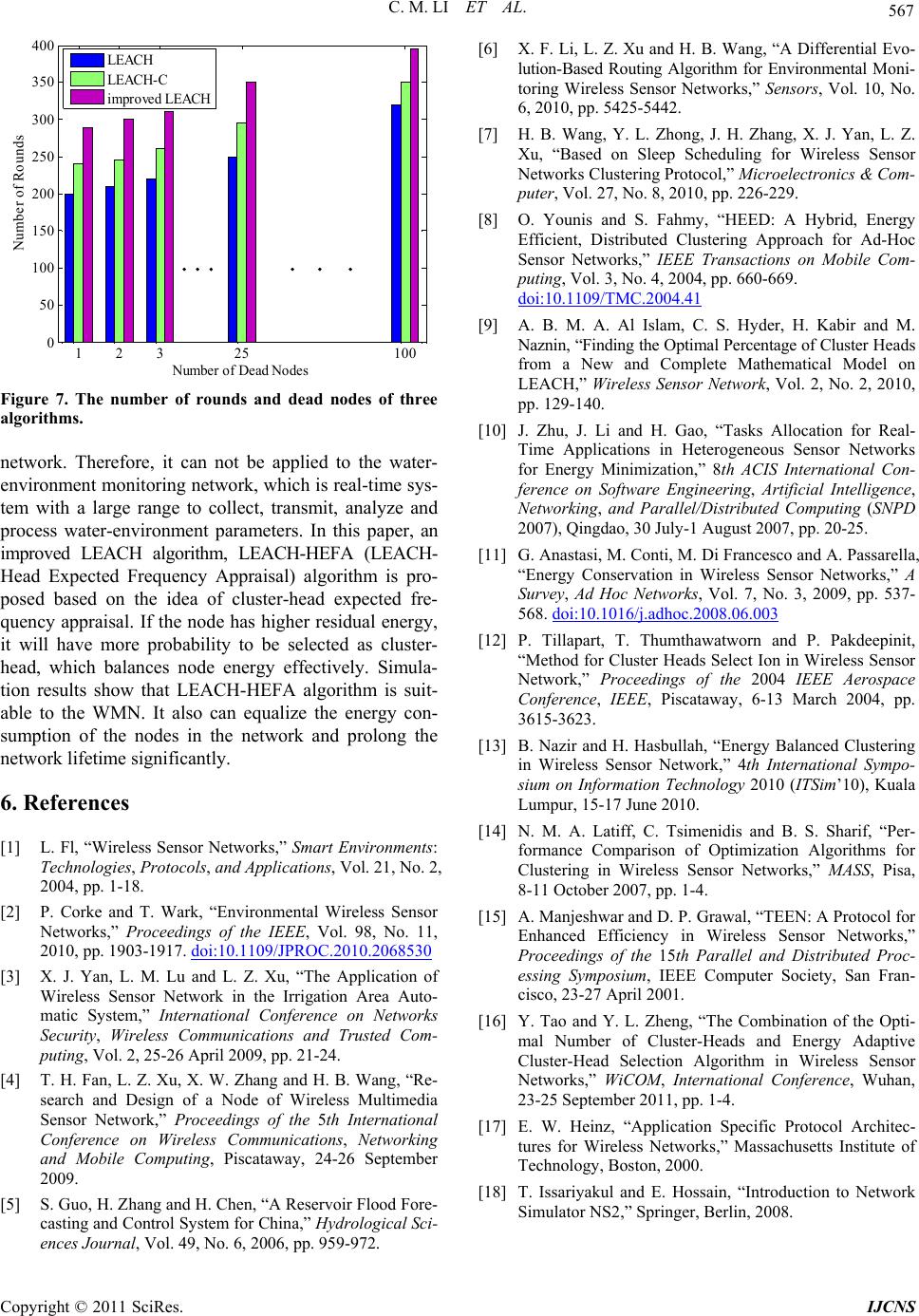
C. M. LI ET AL.
Copyright © 2011 SciRes. IJCNS
567
123 25 100
0
50
100
150
200
250
300
350
400
Number of Dead Nodes
Number of Rounds
LEACH
LEACH- C
improved LEACH
[6] X. F. Li, L. Z. Xu and H. B. Wang, “A Differential Evo-
lution-Based Routing Algorithm for Environmental Moni-
toring Wireless Sensor Networks,” Sensors, Vol. 10, No.
6, 2010, pp. 5425-5442.
[7] H. B. Wang, Y. L. Zhong, J. H. Zhang, X. J. Yan, L. Z.
Xu, “Based on Sleep Scheduling for Wireless Sensor
Networks Clustering Protocol,” Microelectronics & Com-
puter, Vol. 27, No. 8, 2010, pp. 226-229.
[8] O. Younis and S. Fahmy, “HEED: A Hybrid, Energy
Efficient, Distributed Clustering Approach for Ad-Hoc
Sensor Networks,” IEEE Transactions on Mobile Com-
puting, Vol. 3, No. 4, 2004, pp. 660-669.
doi:10.1109/TMC.2004.41
[9] A. B. M. A. Al Islam, C. S. Hyder, H. Kabir and M.
Naznin, “Finding the Optimal Percentage of Cluster Heads
from a New and Complete Mathematical Model on
LEACH,” Wireless Sensor Network, Vol. 2, No. 2, 2010,
pp. 129-140.
Figure 7. The number of rounds and dead nodes of three
algorithms. [10] J. Zhu, J. Li and H. Gao, “Tasks Allocation for Real-
Time Applications in Heterogeneous Sensor Networks
for Energy Minimization,” 8th ACIS International Con-
ference on Software Engineering, Artificial Intelligence,
Networking, and Parallel/Distributed Computing (SNPD
2007), Qingdao, 30 July-1 August 2007, pp. 20-25.
network. Therefore, it can not be applied to the water-
environment monitoring network, which is real-time sys-
tem with a large range to collect, transmit, analyze and
process water-environment parameters. In this paper, an
improved LEACH algorithm, LEACH-HEFA (LEACH-
Head Expected Frequency Appraisal) algorithm is pro-
posed based on the idea of cluster-head expected fre-
quency appraisal. If the node has higher residual energy,
it will have more probability to be selected as cluster-
head, which balances node energy effectively. Simula-
tion results show that LEACH-HEFA algorithm is suit-
able to the WMN. It also can equalize the energy con-
sumption of the nodes in the network and prolong the
network lifetime significantly.
[11] G. Anastasi, M. Conti, M. Di Francesco and A. Passarella,
“Energy Conservation in Wireless Sensor Networks,” A
Survey, Ad Hoc Networks, Vol. 7, No. 3, 2009, pp. 537-
568. doi:10.1016/j.adhoc.2008.06.003
[12] P. Tillapart, T. Thumthawatworn and P. Pakdeepinit,
“Method for Cluster Heads Select Ion in Wireless Sensor
Network,” Proceedings of the 2004 IEEE Aerospace
Conference, IEEE, Piscataway, 6-13 March 2004, pp.
3615-3623.
[13] B. Nazir and H. Hasbullah, “Energy Balanced Clustering
in Wireless Sensor Network,” 4th International Sympo-
sium on Information Technology 2010 (ITSim’10), Kuala
Lumpur, 15-17 June 2010.
6. References
[14] N. M. A. Latiff, C. Tsimenidis and B. S. Sharif, “Per-
formance Comparison of Optimization Algorithms for
Clustering in Wireless Sensor Networks,” MASS, Pisa,
8-11 October 2007, pp. 1-4.
[1] L. Fl, “Wireless Sensor Networks,” Smart Environments:
Technologies, Protocols, and Applications, Vol. 21, No. 2,
2004, pp. 1-18.
[2] P. Corke and T. Wark, “Environmental Wireless Sensor
Networks,” Proceedings of the IEEE, Vol. 98, No. 11,
2010, pp. 1903-1917. doi:10.1109/JPROC.2010.2068530
[15] A. Manjeshwar and D. P. Grawal, “TEEN: A Protocol for
Enhanced Efficiency in Wireless Sensor Networks,”
Proceedings of the 15th Parallel and Distributed Proc-
essing Symposium, IEEE Computer Society, San Fran-
cisco, 23-27 April 2001.
[3] X
. J. Yan, L. M. Lu and L. Z. Xu, “The Application of
Wireless Sensor Network in the Irrigation Area Auto-
matic System,” International Conference on Networks
Security, Wireless Communications and Trusted Com-
puting, Vol. 2, 25-26 April 2009, pp. 21-24.
[16] Y. Tao and Y. L. Zheng, “The Combination of the Opti-
mal Number of Cluster-Heads and Energy Adaptive
Cluster-Head Selection Algorithm in Wireless Sensor
Networks,” WiCOM, International Conference, Wuhan,
23-25 September 2011, pp. 1-4.
[4] T. H. Fan, L. Z. Xu, X. W. Zhang and H. B. Wang, “Re-
search and Design of a Node of Wireless Multimedia
Sensor Network,” Proceedings of the 5th International
Conference on Wireless Communications, Networking
and Mobile Computing, Piscataway, 24-26 September
2009.
[17] E. W. Heinz, “Application Specific Protocol Architec-
tures for Wireless Networks,” Massachusetts Institute of
Technology, Boston, 2000.
[18] T. Issariyakul and E. Hossain, “Introduction to Network
Simulator NS2,” Springer, Berlin, 2008.
[5] S. Guo, H. Zhang and H. Chen, “A Reservoir Flood Fore-
casting and Control System for China,” Hydrological Sci-
ences Journal, Vol. 49, No. 6, 2006, pp. 959-972.